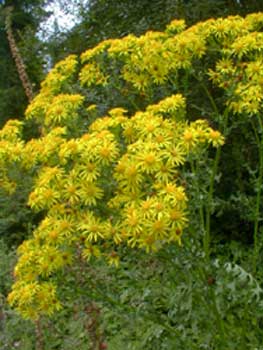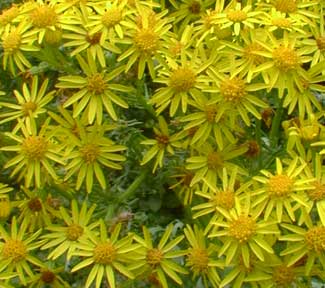
Tansy Ragwort
"Behind, a buried vale doth sleep,
Far down the torrent cleaves its way:
In front the dumb rock rises steep,
A fretted wall of blue & grey;
Of shooting cliff & crumbled stone
With many a wild weed overgrown."
-Matthew Arnold
(1822-1888)
(1822-1888)
Tansy Ragwort is alled Ragwort because the deeply cut leaves look ragged & will be very raggedy by the time it blossoms, & it is Tansy because like true Tansy it is toxic & it has an unpleasant odor like true Tansy.
It has a plethora of additional common names, though Tansy Ragwort has become the most used & standard name. For its odor it has been called Stinking Willie, Stinking Davies, Stinking Alisander, Stinking Ninny, or Stinking Nanny. The most widely used of these is Stinking Willie after William Augustus, the Butcher of Cumberland, who slaughtered many to put an end to the Jacobite Rebellion of 1745. It was said the weed first arrived in Scotland during his campaign on the Culloden moor.
For its toxicity it has been called Staggerweed, Felonweed, Stanerwort, or Yellow Perils. It was called Cankerwort because believed to be a healing aid to open soars, Sleepy Weed for inducing slumber, & Stammerweed because of a misguided belief that taken as a tea it could cure stuttering, though possibly its toxicity had been observed to interfer with speech for whoever overimbibed. It is Tansy Butterweed, or Yellow Weed due to the color of the flowers. It was Fireweed because it was among the first plants to colonize where forests had burned.
It's gone by Kettledock, Dog's Standard, & Slavewort, while the name Fizz-gig or Fizgig means "perverse" or "a frivilous woman" but is also the name of the trident that is held by Brittannia the amazonian personification of Great Britain. One of its many names in Scotland is Weebie or Weebo, "Little Devil." Scots also called it Benweed, Bunweed, Upright Bundweed, Beaweed, Bowlocks, Curly Doddies, or Curly Head.
In most European countries it is associated with the apostle James & thus named for him in many nations. It is St James Wort, James' Weed, herbe St. Jacques, Erba di San Giacomo, Jacobskraut, Jakobskruiskruid, Hierba Santiago & many such. The taxonomic name Senecia jacobea alludes to James in his old age, when his hair became as white as tansy ragwort after it has gone to seed. Senecia means old man & jacobea is from the Latin form of James, vis, Jacobus.
The reason for this association is debated, but Tansy Ragweed can almost always be observed to bloom on St. James Day in late July. Furthermore, James was the patron saint to wandering pilgrims, who used tansy ragwort as a balm to soothe aching feet. James was frequently portrayed on a white horse because of the legend of his having trampled Moors. Some believed he used Tansy Ragwort to cure illnesses of horses, though it's in fact toxic to horses, hence its names Mare's Fart & Fairy's Horse.
 Aster-like flowers about the size of a dime occur in heavy clusters atop leafy stalks. In most areas the stalks are only two to four feet tall, but around here they frequently exceed six feet.
Aster-like flowers about the size of a dime occur in heavy clusters atop leafy stalks. In most areas the stalks are only two to four feet tall, but around here they frequently exceed six feet.Here on the Kitsap penninsula they grow in full sun to bright shade at forest edges & along roadsides & in open fields, sometimes in the harshest hardest soil imaginable, though it prefers disturbed sites. It is sometimes spotted in seasonally dry wetlands or coastal dune environments. It can be in flower anywhere from July to September, but on our penninsula it blooms mainly in August.
It frequently shares ground with foxgloves & fireweeds. The foxgloves will be dried stalks that have gone to seed by the time the Tansy Ragweed is flowering, & the fireweeds will be petering out though still plenty in purple flower.
It generally flowers only its second year but in some areas it will finish its life cycle in one year, hence it's either an annual or biennial that self-seeds with excessive ease. If tansy ragwort is mowed or cut down or broken off at the top of the taproot before it goes to seed, it will perennialize for as many years as it takes to finally go to seed, dying only after it has fullfilled its eager purpose.
A single tall clump can produce a quarter-million seeds, & the seeds can remain viable in the ground for ten to seventeen years. Curiously enough it dislikes competing with tall grasses so does not much invade healthy grasslands, but certainly will infest dry uneven grasslands.
Its as beautiful as an aster or a daisy, so we do appreciate tansy ragwort for wherever it's encountered wild. Though it might seem like a good candidate for a showy native garden plant, it's actually an invader to the Northwest & can be quite a harmful pest plant, not only for displacing native wildflowers but for being very toxic to livestock causing economic damage when it infests pasturelands.
Because it is harmless to sheep, & they like it at high summer better than they like dry stubbly grass, one of the tricks horse & cattle farmers use to keep it out of their pastures is to have some sheep come visit for the summer. The sheep zip around the fields chowing down on tansy ragwort. Unfortunately it invariably grows back from the root, but at least they won't be going to seed & spreading.
It is native to Eurasia, but has spread throughout the world, so is now found in South Africa, South America, Australia, New Zealand & is found on both coasts of North America, being especially common on the Pacific coast, mostly west of the Cascades. It was first recorded as having found its way to Vancouver in 1913, to Oregon by 1922.
In its original range many insects specialize in eating tansy ragwort so that it is much more controlled than when it invaded Oregon cattleland & the Pacific Coast where it had no natural enemies. In the 1950s & 1960s three insects that assault this plant were introduced into coastal rangelands of Washington, Oregon & California with the specific hope of reducing the threat this plant has posed. These were the ragwort flea beetle (Longitarsus jacobaeae), ragwort seed fly (Pegohylemyia seneciella), and cinnabar moth (Tyria jacobaeae).
Here in Washington it is a Class B noxious weed. By law Class B invasives must be destroyed in areas where they are uncommon & haven't yet gotten much of a foothold, but in counties where they are as common as they are here on the Kitsap penninsula, it's too late, they're here to stay, & Class B status does not make us beholden to scour the countryside on hopeless quests.
It was formerly very commonly used as a medicinal plant, for all sorts of ailments most of which it could not effect. A few ailments it may have helped in some cases since it does contain some powerful alkaloids. However, because its dangerous toxins are difficult for the body to expel & can accumulate in the body, its use is today not favored by herbalists who hope not to kill too many paying clients.